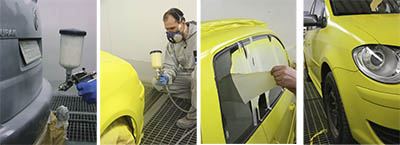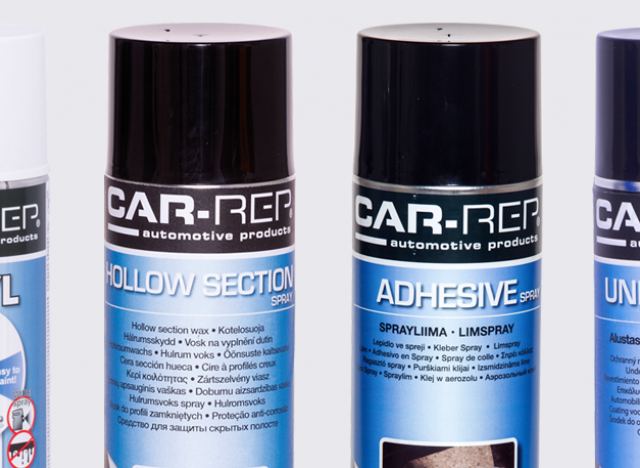CLICK TO SELECT THE TOPIC
If none of the options apply, try "Other"
Distributors and customer service
Car
Metal
Aluminum
Plastic
Rubber coating
Other, e.g. questions about paints
- Where can I find a distributor?
- Please, contact maston(at)maston.fi or by calling +358 (0)20 7188 580
- Can I order Maston products directly?
- Maston operates via its distributors, so we do not sell products directly to end users.
Distributors and customer service
- What CarColor color is best for my car?
- You can find the right CarColor color easily using our car color browser for 400ml spraypaints http://www.car-rep.fi/colorguide/index.php/mastonen or for 12ml Touch Ups http://www.car-rep.fi/touchup/index.php/mastontouchen
Car
- I painted metal with ACRYLcomp: first primer, top coat, and then varnish all in one go. The varnish went on matt but dried with a gloss. The surface stayed soft and cracked. What's the problem?
- The problem is high humidity. Avoid painting in humid conditions if possible. Moisture accumulates in the paint if you apply many coats at once. The moisture causes the varnish to become matt and keep the paint soft. In addition, the moisture breaks the layer of paint as it evaporates. If you need to paint, paint thin layers every 10 minutes. After primer and top coat wait half an hour because the acrylic allows for it.
Metal
- What should I use as a primer for aluminum?
- Use Maston Aluminium & Galvanized primer and there after any Maston-paint.
Aluminum
- I have a plastic barrel I'd like to repaint. What should I do?
- Clean the barrel and degrease it using e.g. Maston degreaser. Treat the base with Maston plastic primer. If the surface is not very flexible, you can apply Maston ACRYLcomp spray over it or, if the surface is flexible, we recommend Maston RR spray paint (sheet metal roofing paint).
Plastic
- RUBBERcomp paint tin and spray, any instructions?
-
Using Maston RUBBERcomp paints and sprays. RUBBERcomp is suitable for all surfaces and can be removed by pulling it off. If you are painting white over dark, first apply a couple of coats of white base coats. The tin of paint will keep, opened, for a year if you add a little thinner (RUBBERcomp Thinner 450 ml) on the surface. If you're painting with a sprayer, here is a mixing guide: 70% w/w RUBBERcomp (according to weight), 30% w/w thinner RUBBERcomp, 76.5% v/v (according to volume) RUBBERcomp, 23.5% v/v thinner RUBBERcomp (= 1 litre RUBBERcomp + 0.3 l RUBBERcomp thinner), Pressure 2.5 - 3.0 bar, nozzle size 1.4 mm (W: Weight, V: Volume)

- What cleaning agent do you recommend for wheels painted with RUBBERcomp?
- RUBBERComp is a 1-component paint and strong degreasing agents or cleaning agents with a high pH value should not be used. We recommend car shampoo and water.
- Can I apply a "clear" varnish over the semigloss black RUBBERcomp?
- Yes you can, it will make the surface glossy. When applying varnish, wait approximately 10-20 minutes between each coat until the surface is "dust-dry".
- I painted a surface with RUBBERcomp but it looks and feels like orange skin, why?
- The painting distance for Maston RUBBERcomp is max. 20 cm. We recommend a distance of 15-20 cm, thin layers of paint, and preferably 4 layers.
- How will RUBBERcomp react if I apply e.g. Maston clear varnish or other "normal paint" over it?
- The paint will no longer come away from the surface, and it will become "normal paint". We recommend RUBBERcomp transparent gloss/matt spray/tinned paint.
- The product info says: "remains flexible for its entire service life, does not crack or become brittle even in extreme weather conditions." What is the expected service life?
- The service life of RUBBERcomp depends on what you are coating. A sufficiently thick coat, sprayed onto the outer surface of a car for example, will last a few years, but it is not a permanent coating.
- Will RUBBERcomp stick to EPDM rubber?
- The surface of RUBBERcomp is soft, so it cannot withstand very high levels of wear or continuous friction. The adhesive properties fo rubber are excellent, so it sticks to EPDM rubber. The rubber's properties are fairly similar to those of EPDM rubber, but it's a little bouncier, it's resistance to weather and ozone are more limited, its durability is better and its gas-tightness properties are better than those of EPDM rubber.
- What instructions do you have for brush painting with RUBBERcomp?
- It's not necessary to thin first before applying with a brush; the surface will be fairly even without thinning. We always recommend several coats in order to achieve a sufficiently thick coat, but it is difficult to say because we don't know what you're aiming to coat. It covers approximately 6-8 m2 per liter applied once to an even surface.
Rubber coating
- Adhesive spray: What are the properties of adhesive spray and how should I use it?
- Maston adhesive spray is a quick-drying, almost colorless and flexible adhesive for gluing light materials and for photography and marketing design. Can be used to glue paper, cardboard, fabric, felt, rubber, fiberglass, styroc and many plastics. Do not use on vinyl plastics or vinyl-coated fabrics. Adheres to almost all smooth and rough surfaces. Is not absorbed into the surface. Water-repellant. Temporary adhesion is achieved if you spray glue onto only one surface. You can achieve permanent adhesion if you spray glue onto both surfaces. Shake for approximately 1 min before use and occasionally during use. Remember to empty the nozzle by turning the bottle upside-down and pressing the nozzle until only propellant comes out. Väliaikainen kiinnitys onnistuu, kun suihkutat liiman vain toiselle liimattavalle pinnalle. Pysyvän kiinnityksen saat, kun suihkutat liiman molemmille liimattaville pinnoille. Ravista purkkia n. 1 min ennen käyttöä ja aika ajoin myös käytön aikana. Lopuksi muista tyhjentää suutin kääntämällä pullo ylösalaisin ja paina suutinta kunnes purkista tulee pelkkää ponneainetta.
- Removing adhesive spray or other glue from e.g. a car?
- As is the case with many other glues, Maston adhesive spray is most easily removed from various surfaces using xylene. Do remember to test the product carefully on a discreet spot to ensure that the xylene does not damage the surface to be cleaned.
- 1K Acid primer (previously known as FyllPrimer) What primer should I use for metal and what can I use 1K Acid primer for?
- 1K Acid primer is suitable for black and stainless steel, aluminum, sheet metal and zinc-coated sheeting. Instructions for use: Carefully clean the surface of any impurities. Shake the can for 2 minutes. Do a test patch. Spray several thin coats every few minutes. When using a primer, 2 coats (15 micron layer) is enough - can be sanded in approx. 15 minutes. (Top coat in 15 minutes or for dry painting). When using sandable paint, apply 4 layers (30-50 micron layer) - can be sanded in approx. 45 min / light sanding or approx. 90 min / wet sanding. Can also be used as coating for steel outdoor storage for 3 months if the thickness of the dry layer is at least 50 microns. After use turn the can upside-down and press the nozzle until only propellant gas comes out.
- Kodinkonemaali domestic appliance paint: Can I use Maston domestic appliance to paint old and worn ovens or stovetops white?
- The Kodinsarja series domestic appliance paint is the same color as domestic appliances. The original white stovetop surface was achieved with enamel. The paint cannot be used to paint stovetops since its heat resistance is limited. The paint would soften as the stovetop heats up.
- Hammer paint: How should I thin Hammer?
- Tinned Hammer smooth and hammered effect varnish can be thinned using xylene or mineral turpentine. Test: Thin Hammer (smooth and hammered effect) with 20% xylene and 20% mineral turpentine. Both will dry to the touch using xylene in 3 hours. Both will dry to the touch using mineral turpentine in 3.5 hours. The hammered effect will be slightly poorer if you use mineral turpentine.

